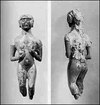Pictures from the lectures slides Flashcards
(55 cards)

Hut Urns from Latin Culture (Latium)- Archaic I Period 1000-750 B.C.
Vilianovian

Geometric Style 750-675 B.C.- Archaic II
Vetulonia beast-headed man and woman (top). Wiry geometric style sculptures from Tarquinia and Vetulonia.

Marsiliana Ivory ca. 650 B.C.- Archaic III Period- Early Etruscan, End of Villanovan Period
Vilianovians
Villanovans- Archaic I and II, Pericle Ducati, Bologna typesite
a. Pozzo and Ziro Tombs
b. Biconical Ash Urns
c. Impasto Ware
Characteristics of Archaic II (750-675 B.C.)
Sculpture- The Wiry Geometric Style
a. Characteristics: open form, not realistic, fork legs, slit eyes, gash mouth
b. The Beast Headed Man and Woman from Vetulonia
Who are the Etruscans?
a. Indigenous People influenced by Assyria, Phoenicia and Greece
b. International Age- May come largely from Po Valley and villages such as
Frattesina on eastern Po.
c. Raw materials to trade- wool, wine, iron, copper
Tumulus
- Krepis
- Dromos
- Stele
- Corbel- corbeled arch
- Cerveteri/Caere/Agylla
Bucchero
Ungly Ethrascan pottery
dodecapolis
and
Lucumones
League of 12 Cities- dodecapolis
Leaders of these cities were called Lucumones
Romulus
first king 753-717 B.C.
Rome before the Etruscans
Etruscan Contributions to the Romans
- Ivory thrones
- Folding Chair
- Purple tunic
- Temples
- Large architecture
- Lictors and fasces
- Circus
- Gladiator combats
- Hydraulics
The Regolini-Galassi Tomb
- 650 B.C.- rebordered 6th century B.C.
- 5 tombs added to original
- Dromos
- Camera
- Sigillum
- Tamburo- crepis, torus, listellum
- Alae- right ala with man in bronze biconic urn, left with burned biga
- Corbel
- Antechamber- bronze bed of noble warrior, chariots, shields
- Cella with Larthia


Tomb of the Shields and Chairs
Tomb of the Reliefs
600-550 B.C., Cerveteri
300 B.C., Cerveteri
The Tomb of Hunting and Fishing at Tarquinia
ca. 510 B.C.
The Tomb of the Lionesses, ca. 530 B.C.
- Doric capitals
- Funerary banquet with dancers
- Cithara
- Auloi
- Tutulus
- Histriones
- Cymbals and castanets
- Eggs and kylix
The Archaic Style
Archaic smile, profile eye, stylization, 600-500 B.C
- Chunky figures more detailed than in Archaic III
- Large heads, pointed beards, large feet and hands
- Almond sideways facing eye, profile head, frontal torso, profile legs
- Lack of contropposto or chiastic weight shift
- Stylization of drapery and hair braids, echelon technique for horses and clothes
The Tomb of the Augurs
The Tomb of Hunting and Fishing at Tarquinia
C. The Tomb of the Augurs- ca. 530 B.C.
- Bloody funeral games- blood sacrifices to dead
- Phersu
- Tomb name is wrong– a misnomer
- Herakles and Cerberus in Tertullian
D. The Tomb of Hunting and Fishing at Tarquinia- ca. 510 B.C.
- Paesaggio vs. Megalographic painting
- Joie de vivre
- Horror Vacui
- Apotropaic
- Lack of taxis
- Compare with Greek painting at Paestum, South Italy, Tomb of the Diver
Piacenza Liver
found 1877 in Po Valley
- Usils the sun god
- 16 divisions of the heavens
- Lightning, manubia controlled by the 6
- 1=warning, 2=terrifying good omen, 3=destruction
- Di Consentes
- Haruspex consults Disciplina Etrusca
- Thunder on left of God good
The Athrpa Mirror
Hellenistic Period, from Perugia, now in Berlin
- Turan, lover of Atune
- The inevitability of fate- the nail of fate
a. Temple of Fortuna at Volsinii- cella nail
b. Saeculum - Atlenta and Meliacr= Atalanta and Meleager
- Athrpa/Atropos- destiny gives mother of Meleager the wooden log
- ca.320 B.C.
Augur
alites, oscines, auspices, pullareus, epilepsy, 2 headed calves
referee
Doric Temple Characteristics
a. Column shaft and fluteso
b. Echinus
c. Abacus
d. Triglyphs
e. Metopes
f. The Angle Triglyph Problem
g. Pediment
h. Tympanum
i. Cornice- horizontal, side and raking
j. Acroteria
Ionic
a. Base
b. Arrises
c. Torus and scotia
d. Echinus, volutes, abacus
e. Fasciated architrave
f. Frieze
g. Slender and graceful
h. Anatolia first–Turkey, western Asia Minor
Carthage
- The Phoenician Arrival- ca,. 814 B.C. Queen Dido/Elissa
- The Age of Hannibal- 3rd century B.C. wars with Rome- Punic Wars 264-146 BC
Key Dates for Carthage
- Ca. 800 B.C.- founded by Queen Dido and the Phoenicians
- 6th to 4th centuries B.C.- The Golden Age, Mediterranean Power- Increasing democratization
- 3rd century B.C.- The Punic Wars–Carthage against Rome
- 146 B.C.- Complete destruction of Carthage by Scipio Aemilianus
- Early First Century A.D.- rebuilding of Carthage by Augustus/Tiberius



